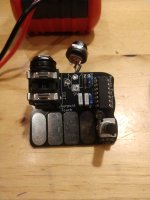comradehoser
Well-known member
Built the Moonn "Cyberpunk Touch" and "Drone a Little Drone", but forgot to order pcb mount barrel jacks. So, I just soldered in some wires from a regular 9v enclosure jack to the PCB jack pads, ground to the round pad in front, and hot to the square pad in back. Didn't bother with the switch lug on the side.
Problem is that I get ticking and no signal. So what am I missing in the difference between a regular 9v jack and a board mount 9v jack?
The same ticking and no signal happened on my last batch of Moonn boards when I inadvertently introduced 9V into the ground (I think) by directly connecting the 9v supply with the LED ground on the 3pdt. So somehow I'm getting a 9V/ground path? Is it necessary to cut the trace from switch pad to the ground pad? I tried connecting switch prong on the jack to switch pad, same problem.
It's definitely not a fault in my assembly besides the 9v. I found external +/- pads on the Drone PCB, and after soldering things there, it worked, but initially it was exactly the same problem.


Problem is that I get ticking and no signal. So what am I missing in the difference between a regular 9v jack and a board mount 9v jack?
The same ticking and no signal happened on my last batch of Moonn boards when I inadvertently introduced 9V into the ground (I think) by directly connecting the 9v supply with the LED ground on the 3pdt. So somehow I'm getting a 9V/ground path? Is it necessary to cut the trace from switch pad to the ground pad? I tried connecting switch prong on the jack to switch pad, same problem.
It's definitely not a fault in my assembly besides the 9v. I found external +/- pads on the Drone PCB, and after soldering things there, it worked, but initially it was exactly the same problem.


